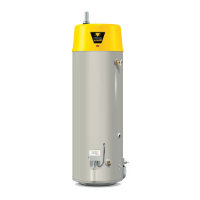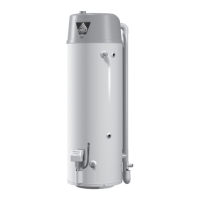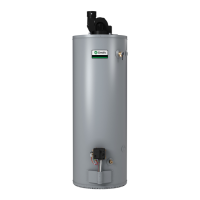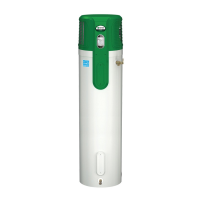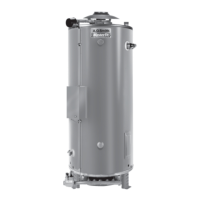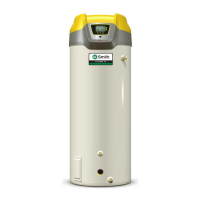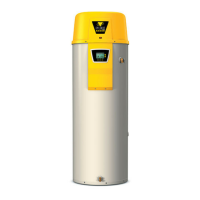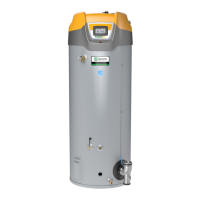23
VENTING INSTALLATIONVENTING INSTALLATION
Breathing Hazard - Carbon Monoxide Gas
•
Install vent system in accordance with codes.
•
Do not operate water heater if any part has been
exposed to flooding or water damage.
•
Do not operate if soot buildup is present.
•
Never operate the heater unless it is vented to
the outdoors and has and has adequate air
supply to avoid risks of improper operation,
fire, explosion, or asphyxiation.
•
Do not obstruct water heater air intake with
insulating jacket.
•
Do not place chemical vapor emitting products
near water heater.
•
Analyze the entire vent system to make sure
that condensate will not become trapped in a
section of vent pipe and therefore reduce the open
cross sectional area of the vent.
•
Gas and carbon monoxide detectors are available.
Breathing carbon monoxide can cause brain damage or
death. Always read and understand instruction manual.
VENT INSTALLATION CONSIDERATIONS
This water heater can be vented using room air for intake combustion
air, or direct vented so that all intake air for combustion comes from
the outside through a sealed pipe.
The water heater venting may be installed in 4 separate orientations
depending on the requirements of the building and the water heater.
The installer must decide which method is most appropriate for each
installation. These orientations are:
1. Vertical Termination - vertical vent termination through
unenclosed or enclosed areas with roof penetration. See
Vertical
Vent Terminal Installation
(page 26).
2. Through-the-Wall Termination - horizontal vent termination
directly through an outside wall. See
Figure 17
(page 25).
3. Horizontal Direct Vent - using Through-the-Wall Termination to
exhaust ue products and piping to bring combustion air to the
water heater from the outside. See
Figure 20
(page 26) and
Figure 28
(page 30)
and
Figure 29
(page 30).
4. Vertical Direct Vent - using a vertical vent termination to exhaust
ue products and piping to bring combustion air to the water
heater from outside. See
Figure 26
(page 30) and
Figure 27
(page 30).
In cold climates any water vapor remaining in the ue gases will
condense into a cloud of vapor at the point where the vent system
exits the building. Special consideration is recommended, before
locating the vent termination near walkways, windows and building
entrances.
Direct venting into dead spaces such as alleys, atriums, and inside
corners can cause recirculation of ue gases. Recirculation of ue
gases will cause sooting, and icing of the combustion air intake
during severe cold weather. To prevent the recirculation of ue gases,
maintain as much distance as possible between the combustion air
intake and the exhaust vent terminal. See
Figure 24
(page 28)
and
Figure 25
(page 29).
Installation of this water heater must comply with the current edition
of
CSA-B149.1
-
Natural Gas and Propane Installation Code
which requires
the vent system components be certied to
ULC S636
.
Approved vent pipe materials that must be used:
• ULC S636 PVC / CPVC
• ULC S636 Polypropylene - See
Polypropylene Installations
(page
24)
.
Approved intake air pipe materials that must be used:
PVC pipe materials:
• DWV ASTM-D2665 or CSA B181.2
• Schedule 40, 80, 120 ASTM-D1785 or CSA B137.3
• SDR Series ASTM-D2241 or CSA B137.3
CPVC pipe materials:
• CPVC 41 ASTM-D2846 or CSA B137.6
• Schedule 40, 80 ASTM-F441 or CSA B137.6
• SDR Series ASTM-F442
Polypropylene - See
Polypropylene Installations
(page 24)
.
• M & G Duravent PolyPro vent system
• Centrotherm InnoFlue vent system
Where applicable, the installation of the venting system should
be done in accordance with the venting system manufacturer’s
instructions.
Note: The use of cellular core PVC (ASTM F891), cellular core
CPVC, or Radel® (polyphenolsulfone) in non-metallic venting
systems is prohibited. Covering non-metallic vent pipe and
ttings with thermal insulation is prohibited.
If the water heater is being installed as a replacement for an existing
power vented heater in pre-existing venting, a thorough inspection of
existing venting system must be performed prior to any installation
work. Verify that correct material as detailed above has been used,
and that the minimum or maximum vent lengths and terminal location
as detailed in this manual have been met. Carefully inspect the entire
venting system for any signs of cracks or fractures, particularly at
joints between elbows and other ttings and straight runs of vent
pipe. Check system for signs of sagging or other stresses in joints
as a result of misalignment of any components in the system. If any
of these conditions are found, they must be corrected in accordance
with the venting instructions in this manual before completing
installation and putting the water heater into service.
Note: For water heaters in locations with high ambient temperatures
above 100°F (38°C) it is recommended that CPVC or
Polypropylene pipe and ttings be used.
All vent (exhaust) pipes must be pitched a minimum of a 1/4” per
foot back to the water heater to allow drainage of condensation.
Never operate the water heater unless it is vented to the outdoors.
The instructions in this section of the manual must be followed
to avoid choked combustion or recirculation of ue gases. Such
conditions cause sooting of the combustion chamber, burners and
ue tubes and creates a risk of asphyxiation.
For direct vent application where combustion air might be supplied
from cold outdoor ambient temperatures through the fresh air intake
piping system, it is recommended that a backow preventer and /
or a drain tee be installed in the air intake before proceeding with
installation of the rest of the fresh air intake piping. See
Direct Vent
Air Intake Moisture Protection
(page 26) or call the toll free number
found on the warranty sheet provided with the water heater for
technical assistance.
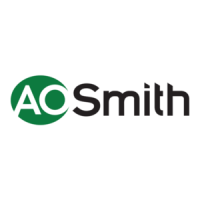
